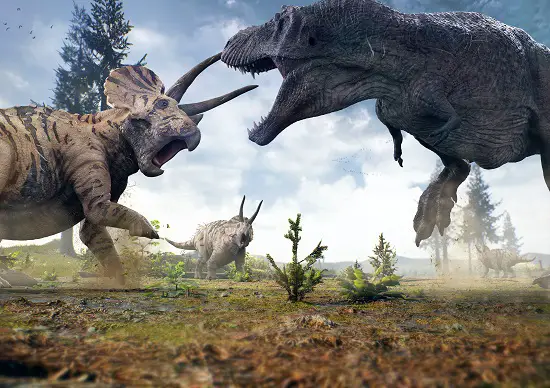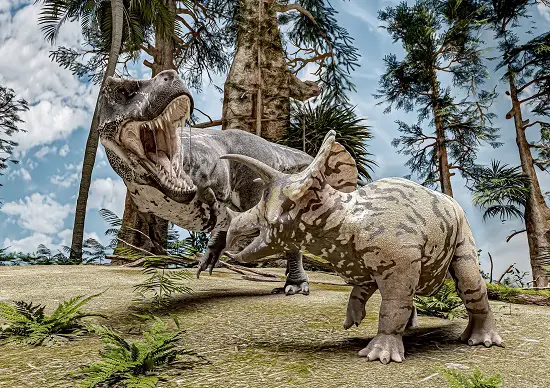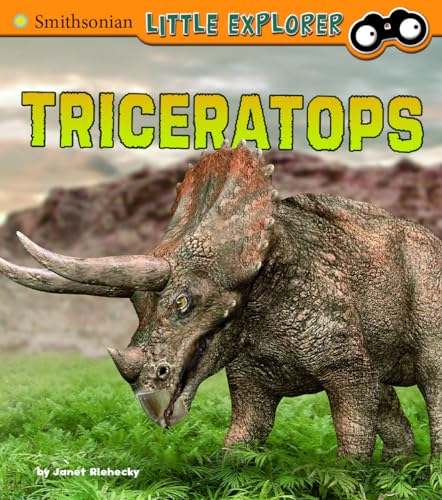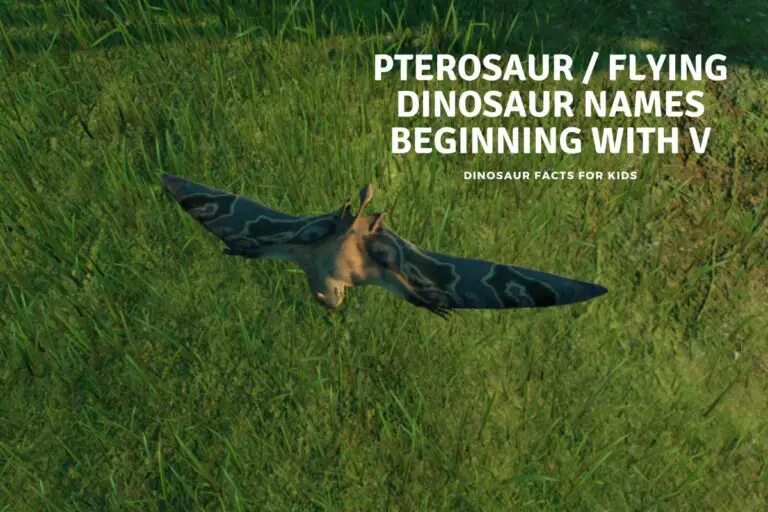Why Did Triceratops Have a Frill? – 7 Reasons
Aside for the three horns one of the most instantly recognisable features of the triceratops is the huge neck frill. In fact this frill gave the horned dinosaurs, ceratopsians, one of the largest skulls and heads of all dinosaur species and while occasionally acting as defense against predators its usefulness did not stop there. there were, or at least theorized, multiple functions of a triceratops frill which is what we will look at in the article below.
Triceratops, and other Ceratopsian (horned dinosaurs) possessed multi-Functional neck Frills. Although Modern Media depicts these as primarily protection against carnivorous dinosaurs they also acted as a means of species recognitions, attracting mates, display, thermoregulation and attachments for jaw muscles.
The group that triceratops belong to is called the ceratopsians, which directly translates as “horned face” however although plenty of this family did feature horns on their face there were also plenty that did not.
One anatomical feature that was almost always present was the neck or head frill that extended from the back of their head and skill to cover that venerable back and neck area. this could vary is size, and we look at some of these differences below, but was almost universally present.
it could be elaborate and decorated like the kosmoceratops and Regaliceratops or it could be considerably more basic like in Psittacosaurus and microceratus but whether large or small the frill was almost always there and is arguably the feature that these “horned face” dinosaurs should have been named after.
The article below takes a more in-depth look at the purpose of these frills and how they have changed during the millions of years of evolution that these dinosaurs experienced. However, just so we all start from the same stage we take a look at what exactly a ceratopsian dinosaur was first. .
What is a Ceratopsian
Ceratopsians are dinosaurs that lived mainly during the Cretaceous period about 100 to 66 million years ago. Although the suggested first example of these horned face dinosaurs, Yinlong Downsi, was actually alive in the Mid to late Jurassic Period.
They were possibly initially bipedal animals, and members of the bird hipped group of dinosaurs, but later species developed large quadruped bodies with elaborate facial horns and frills around their necks.
Today, most people know about triceratops, a large, horned dinosaur. Which as well as one of the most recent dinosaurs to live, it went extinct at the end of the cretaceous period 66 million years ago. it was also one of the largest at up to 30 feet in length and 18,000 lbs in weight.
They were large herbivores, with narrow beaks and deep gut cavities. Their horns helped them protect themselves and served as defense against predators although like the neck frills it is now thought they may have had other functions as well, like heat regulation and display.
What makes a ceratopsian different from other dinosaurs?
Their horns and frills were evolved over time. While some ceratopsids had horns on their brows and noses, some were equipped with a crest and brow horns. Their nasal horns were used as a defense against predators and intimidated other males for their mating rights but more likely as a display of prowess.
However both these frills and horns made them very distinctive from most other dinosaurs, and although there were rare examples of carnivore dinosaurs like Carnotaurus and ceratosaurs, having at least horns, if not frills, these were the exception rather than the rule.
Examples of ceratopsians
Ceratopsians were herbivorous dinosaurs. Their beaks, neck frills, and horns all gave them distinctive features. Named after their horns, Ceratopsia was first described by Othniel Charles Marsh in 1890. The group of dinosaurs grew from small bipeds into large, quadrupeds. They developed elaborate facial horns and neck frills that served as thermoregulation and display features.
Most of the species of ceratopsians had beaks. These animals fed on tough vegetation. Triceratops, for example, had a massive, heavy frill that may have served as armor against its saurischian predators. Ceratopsians also had smaller frills, but with large openings, and their frills may have served as heat radiators or signaling devices.
We have examples of the more well known, and some lesser know ceratopsian horned face dinosaurs in the table below.
Table 1: Triceratops and 15 other ceratopsian Dinosaurs.
| Triceratops | Eotriceratops | Nasauceratops | Pentaceratops |
| Kosmoceratops | Regaliceratops | Psittacosaurus | Microceratus |
| Wendiceratops | Utahceratops | Sinoceratops | Centrosaurus |
| leptoceratops | zuniceratops | pachyrhinosaurus | styracosaurus |
| Chasmosaurus | Gryphoceratops | Graciliceratops | Yinlong |
Why did the Triceratops have a Frill on Its neck?
We will highlight the theorized reasons why triceratops had a neck frill, and in fact why all ceratopsian ( horned face) dinosaurs would have had them in the list below. There could be multiple reasons why these herbivore dinosaurs would have neck frills, not just, as you will discover, for defense from predators.
1. Triceratops frill was a form of display
A triceratops skull is characterized by a large bony frill on top of the skull, and three dramatic horns that extend from its head. Its fearsome appearance makes us imagine a prehistoric battle between the Triceratops and a potential predator. However, despite its impressive size, the frill was not particularly thick or strong, and was likely simply a form of display.
The triceratops’ frill may have been a form of display as well as a functional tool for defense and attack as live science explain these display functions could have been used both as warnings to predators, to competitors for mates or to the herd, although in the case of triceratops the jury is still out on whether it moved or lived in herds, there is evidence for other horned face dinosaurs living in herds.
possible display uses for the triceratops frill.
- To warn off predators and show it was an animal that could defend its self.
- To attract mates and show how strong the animal was and how suitable for breeding probably in tandem with the horns / tail feathers ( on some) as well.
- To warn other members of the herd of predators close by
The Triceratops skull is an impressive one, reaching a length of over seven feet. Most ceratopsians had bigger, more elaborate skulls. The larger the head, the more attractive the male would be to females, and this trait would be passed on to their offspring being through out generations the frill would grow in size, decoration and strength.
2. It may have been used to signal other members of the herd
As we mention a few times above this frill on the triceratops may have served multiple purposes. Although we are not completely sure of the color of triceratops there have been increasing suggestions that it may have been more brightly colored than traditionally thought. You can read more about the color of a triceratops here.
With other ceratopsians like kosmoceratops, and Chasmosaurus these frills became more ornate and decorated and may have even been brightly colored to use as a visible signal to the herd, and to recognise members of the species and group from a distance to show direction of travel.
As well as a warning to predators to stay aware, it could have also been used to alert other members of the herd of the presence of danger, rapid head movements ( kind of similar to how a rabbit will flash the white section of its tail) would be very noticeable to other dinosaurs in the area. However this is not evidenced and just theory.
Also the larger, more noticeable the frill would also send a message to other males ( usually) about where the pecking order in the herd stood and may have prevented painful, and often damaging fights between males from occurring.

3. It provided additional surface area for the attachment of jaw muscles
The frill was highly vascular, which means it had many channels allowing blood to flow to the jaw and around the head. So while it may have served a defensive function, probably used for display or interspecies competition. it also may have had a more basic and biological function
Frills were thought, although heavily disputed, to have been necessary for the attachment of jaw muscles, and a paleontologist called John McLoughlin even wrote a book focussing on this alternative view.
However as for this to happen, or at least be an important reason why triceratops and other horned face dinosaurs had frills, those frills and in fact most of the head would have to be much less mobile that is currently thought and this theory has not been accepted by the majority of scientists you can read more on Tetzoo.com here.
4. It was a result of sexual selection
Researchers have long questioned the reason why a Triceratops frill evolved. Some believe it is an aesthetic trait, while others suggest it evolved as a means of attracting a mate. Scientists have studied the skulls of several species of dinosaurs and their skulls to understand how they developed frills.
To determine the reason why the Triceratops and other ceratopsian dinosaur frills developed, researchers studied 30 fossilised skulls of the Protoceratops, a relatively common horned face dinosaur from Mongolia’s Gobi Desert. The researchers were able to identify a distinct pattern of growth in each of the specimens – from tiny hatchlings to fully grown adults as they approached sexual maturity.
According to researchers from the Natural History Museum, the Triceratops frill evolved from females to males through sexual selection. This process favors traits that the opposite sex will be attracted to, such as horns and feathers and of course the most noticeable of these, the frills.
Display to attract mates is nothing new, and in fact nothign old, and many animals do the same today, peacocks feathers, lions manes, birds of paradise etc. In fact although we have put this as number 4 on this list of why triceratops had a frill, it is actually the most likely and probably reason for it developing, and developing to the size they did.
5. Triceratops Frill Protected it from Fights Between Males.
The triceratops frill was made of bone and both strong and robust. Now while theories mostly point at the main reason for the frill as a display tool for attracting mates, it doesn’t mean it didn’t serve other purposes as well. One of which is protection.
traditionally, at least in movies and television, this protection is thought to be from large predators, it is more likely it offered defense against the horns of others in its own species. Triceratops especially had long pointed horns, but others ceratopsians ( horned face) dinosaurs also had horns as well.
Although, again, these horns may have been used as a signal or display of strength more than anything else, they were also there as a deterrent and at times a weapon. A large neck frill made of bone certainly would have afforded some protection against the horns of a competitor at least in head on confrontations.
In fact Wounds have been on old triceratops fossils that have been attributed to battles between others of the same species. As National Geographic explained
Triceratops was effectively a reptilian knight that carried two lances and a shield on top of its enormous head.
National geographic
6. Triceratops Frill Helped Regulate Body Temperature.
there have been multiple studies that have researched if the frills of ceratopsians including triceratops had thermoregulation features as well as the other highlighted reasons in this list. In fact studies of the horns in particular have suggested that they played a large role in cooling their brains!
However this research, accessible here but heavy going!, also found that the frill and the blood flowing through it would be able to help regulate an control blood, and body, temperature as well. So the frill may have been primarily used to attract mates but it certainly had more uses than just a sign post for other triceratops – or any other member of the ceratopsian family.

7. Triceratops Used Its Frill For Defense Against Predators
Finally, and although it may be the most popular theory on the use case for all horned dinosaur frills and horns is that they were used as defense against predators. this theory is especially popular in movies with triceratops fighting Tyrannosaurus Rex, and in the Jurassic Park series of movies, especially Jurassic Word dominion dinosaurs like Nasauceratops using them to hit and flip cars!
However as much as it is cool to think of these two massive dinosaurs facing off against each other, it would have been much rarer than most people think.
it did happen though and the scars and teeth marks in frills of triceratops and other horned face dinosaur fossils has proved it most certainly did afford some defense but these battles would not be common place. The reaction upon seeing a Tyrannosaurus Rex that you have would have been the same for most dinosaurs at the time. –RUN!
When cornered, or trapped then yes, those horns and frills that were most likely used to attract mates and distinguish between other horned face dinosaurs ( over 60 have now been identified) could when their back was against the wall been used to inflict damage but really they were there to show off to females rather than protect against or skewer a T -Rex.
Conclusion
We have highlighted seven reasons that triceratops may have had large neck frills in the article above, and research has shown that is was most likely as an attraction technique to show how strong they were and to encourage breeding.
however, evidence has certainly shown that even if this was the main reason it was not the only one. Display to rival males, protection in battles over mates, heat regulation and when absolutely no choice as a shield to accompany their horns in defense against predators are also reasons why triceratops and in fact all ceratopsians had frills.
Sources
- https://blog.everythingdinosaur.co.uk/blog/_archives/2018/03/23/why-did-horned-dinosaurs-have-fancy-frills.html
- https://www.nhm.ac.uk/discover/dino-directory/triceratops.html#:~:text=The%20Triceratops%20frill%20might%20have,species%20to%20recognise%20each%20other.
- https://www.bbc.com/news/science-environment-43472777
- https://www.dkfindout.com/us/dinosaurs-and-prehistoric-life/dinosaurs/triceratops/
- https://www.sciencefocus.com/news/dinosaur-frills-were-for-attracting-mates-not-protection/
- https://www.jstor.org/stable/4523952
- https://www.nationalgeographic.com/science/article/old-wounds-show-that-triceratops-used-its-horns-for-combat
Hi, I am Roy Ford a General Studies and English Teacher who has taught all over the world. What started as a fossil collection became a great way to teach, motivate and inspire students of all ages and all over the world about dinosaurs and from that and children’s love of dinosaurs came the site dinosaur facts for kids, a resource for all ages.










